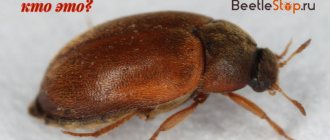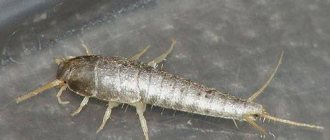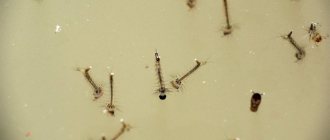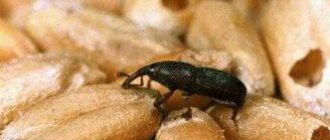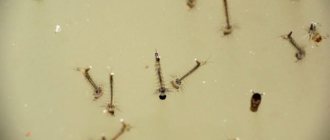It must be admitted that many have not heard anything about small black-brown beetles - leather beetles. Which is strange, because the skin beetle is not such a rare guest in the apartment.
“Carpet beetles are black or brown beetles, 1.3-12 millimeters long. The body can be either elongated or round. The integument is covered with scales or hairs...”
Wait, are you sure you are interested in reading this further? Let's leave the encyclopedic description for amateur entomologists. After all, in the end, skin beetles are unlikely to be interesting to most people in themselves. You usually have to look for information about them when pests make themselves known in the apartment, for example in the sofa or on the windows. But you also need to know about the weaknesses of the “enemy” in order to be a “winner”.
Who are leather beetles and what do they look like?
Are there little brown bugs in your house? In this case, a photo is necessary to find out what they look like and compare whether you really have skin beetles.
It seems that the name of these beetles speaks for itself. However, not all skin beetles respond to this and eat only the skin; their diet is too varied. To be more precise, the concept of “inedible” is not familiar to the skin beetle. Brown bugs feed on everything; they can equally successfully use both ordinary synthetic fabric and cardboard with glue as a substrate. Plastic or even plaster are also used (biting into the walls). And yet, the domestic leather beetle lives primarily on materials of animal origin. The exception is the fur coat beetle, which, contrary to its name, shows more interest in Hercules bread and oatmeal than in “fur coats”. Perhaps that is why the economic damage from it is not so great compared to its other relatives in the family.
White bugs
Small white insects in the apartment can also bother residents. They appear in the house due to dampness and lack of proper cleanliness. It is possible for them to enter the home through unclosed doorways or windows, holes in risers and walls.
It is not difficult to recognize ants or cockroaches, which is impossible to say about small bugs of unknown origin. To get rid of parasitic individuals, you need to know what they look like.
The most famous insect that lives in apartments is the silverfish, or woodlice. The wingless variety with an oblong body has numerous legs. The silvery surface of the bug appears transparent in sunlight. The food for this is starch and products containing it. Due to its damp habitation, it is not difficult to find in bathrooms or kitchen sink areas.
Because they live on book bindings and glued pages, they are called “book louse.” The sugar variety of pests is found in food boxes, food storage warehouses, and libraries. They are difficult to notice because they appear on the surface after dark.
Whiteflies live on indoor plants. Rescue from the bug is caused by treating the affected leaves and soil with a weak solution of manganese. White bugs in pieces of furniture in the kitchen are food midges that eat bulk foods. They are characterized by rapid reproduction. The cause is premises without proper sanitary treatment. Such an area is an ideal habitat for them.
Their settlement is facilitated by excessive humidity, uncollected crumbs and other debris. Insects can infest one type of product and easily move to neighboring food, vigorously attacking hermetically sealed objects.
To combat this, agents and chemicals that do not pose a risk to human health are effective. Comprehensive pest control leads to the desired result. It is necessary to free the room from traces of cobwebs, dust and all kinds of contaminants, followed by disinfection with chlorine-containing substances from a series of household preparations.
After the surfaces have dried, hidden holes and corners are wiped with copper sulfate. Heat fans or hair dryers are most effective. At the final stage, the rooms are cleaned with the addition of vinegar water. Magazines and books are checked for insect eggs being laid in them. The shelves should be sprayed with water with the addition of lemon or intensively blown with a vacuum cleaner.
For what materials is leather beetle dangerous?
Carpet beetles primarily pose a danger to products made of leather, fur, silk, wool, skins, felt, hair, horns, feathers, down, etc. The beetles will also not refuse the following foodstuffs: meat, cheese, dried and smoked fish, powdered milk , some types of grain products.
An alternative to natural food in the form of glue, including that contained in book bindings, seems very “tasty” to the skin beetle. Cardboard, asbestos, rubber or plastic from which the cables are made - all this can also be damaged if skin beetles appear in the apartment.
Signs of defeat
Wood-boring beetles reproduce very quickly. These pests begin to destroy wood at an early age
Therefore, it is very important to promptly notice signs of their presence on the site.
Presence of holes on wooden surfaces. The beetles that live in the house always make small holes or full-fledged passages in the tree. Wood flour often pours out of them. Small larvae can also hide in these passages.
Light weight of building materials
When buying boards for finishing a house or bath, you should pay attention to their weight. If the tree seems too light, this may also be a sign of woodworm damage.
They usually eat the board from the inside.
Unpleasant sound. If there is a beetle in the house, you can recognize it by its characteristic grinding sound. It is heard especially well at night.
Presence of dark spots on the surface. In some cases, brown liquid may ooze from the holes made by woodworms. It has a pungent odor and spoils the appearance of the furniture.
In the evening, these pests can be seen with the naked eye. The easiest time to spot them is during mating season. That's when they leave their shelters. Pests crawl on countertops, window sills, and also fly near lamps. Having noticed such bugs, you need to immediately begin pest control.
Where do skin beetles live in an apartment? How to find these beetles?
Adult beetles fly around the apartment and can unexpectedly and loudly “fly into someone’s forehead” without calculating their flight path. Until this happens, it is better to be the first to find those who replenish their fat reserves by destroying valuable materials. The beetle prefers warm, dry places; they can often be found near a radiator, on a windowsill, in a closet drawer, as well as under carpets, in and near sofas, in mattresses, etc. Skin beetles are often seen in the kitchen; for example, many people find beetles with their legs upside down on the kitchen stove.
There can be much more beetles than it might seem at first glance, because most of them are hidden from human eyes in the form of larvae that have gnawed into the substrate, which are actually engaged in sabotage of valuable materials, products, etc. Until you find out what attracts beetles to your home, it will be impossible to localize the source of their spread.
Carefully inspect your sofa, especially its upholstery, from all sides. This place is the most frequent stronghold of skin beetle larvae.
It also happens that there is simply no specific outbreak - clothes in closets, contaminated cereals, etc. For example, carpet beetles choose hard-to-reach places from which dust and dirt are rarely swept away, or where they accumulate most quickly. The larvae of these beetles feed on a layer of dust, small pieces of various materials - paper, carpet lint, hair and various organic debris. This kind of residue appears in any apartment within a couple of days after cleaning, under cabinets, beds, etc. (even if no one lives in it).
“Where do skin beetle larvae most often like to settle? Under the baseboards. Trite? Maybe, but sometimes there’s just nowhere for them to hide like underneath.”
Adult Smirnov's skin beetles, as a rule, crawl onto windows and lamps; they can be found between window frames or inside lamp shades.
Prevention methods
To prevent the skin beetle from entering the room, a number of measures are carried out:
- Ventilate regularly and do wet cleaning. Insects seek dry environments.
- Twice a year they go through clothes in closets. Lavender, wormwood, tansy, tobacco, and camphor are left on the shelves.
- In the kitchen, surfaces are often treated with vinegar, the garbage is taken out and the bucket is treated.
- Wash the floors thoroughly with the addition of cleaning products to wash away the larvae from the cracks.
- Mosquito nets are hung on the windows.
- Create conditions for storing cereals and other food products.
Washing powders, bleaches, ammonia, and chlorine have no effect on kitchen pests. If you were unable to get them out of the house yourself, specialists will come to the rescue. To clear your apartment of uninvited guests, you may have to leave your home for several days.
Top 6 skin beetles by prevalence in Russia
The leather beetle family includes 600 species of beetles, many of them are morphologically similar to each other. However, out of all the variety of subfamilies and species, only seven are dangerous pests. They pose the most serious threat to food, things, and indeed the sanitary and epidemiological situation of the apartment as a whole. And it’s not so easy to find out what type of skin beetle the uninvited guest belongs to. To get rid of them, by and large, you don’t need to know this, because the tactics for exterminating all skin beetles are approximately the same.
There are 4-5 types that are comfortable in a city apartment. It should be noted that they can get along just fine without fur and with leather.
1. Ham skin beetle is the most common on the Eurasian continent. It can start in a person's house. The ham skin beetle is found quite often in apartments. The beetle is oblong in shape, black in color, with a yellowish-gray (or brown) part at the top of the wings.
2. Carpet beetles - this is the common name for a small group of 2-3 dark brown leather beetles, which are united by the fact that they are able to feed only on particles of house dust containing the smallest organic debris (fur coat beetles, carpet beetles, etc.). Often found in everyday life. Only the larvae feed; the adult beetle goes without food, using up its accumulated fat reserves.
Most likely, having discovered several such strange individuals, it will never occur to anyone that it is a skin beetle, especially if you do not know that it grows in houses. They are most often called by what they look like—little brown bugs.
3. Smirnov’s carpet beetle is a small brown bug reaching a maximum of 3 mm in length. It was brought to Russia about half a century ago, but during this time it managed to adapt to living in private houses and became a full-fledged synanthrope. It is this type of skin beetle that loves windows and window sills in apartments.
4. The fur coat beetle is a black spotted beetle with five small white spots on the back. It is not as harmful as other species, and is also quite rare in apartments. But if he gets into an apartment, he mostly eats food, but does not touch the products.
5. Museum and house leather beetles - they can live in flowers in apartments and houses, but are practically not found in home life, despite the fact that the name of the latter is “brownie”.
6. Frisch's carpet beetle is a black oval beetle; in our practice, there have been no cases of infestation of apartments with this species.
The most common species of carpet beetles in the European part of Russia and Siberia are the carpet beetle and the Smirnov carpet beetle. These are the so-called “little brown bugs on window sills and plastic windows.” But it is not uncommon for both ham and fur skin beetles to appear in the house (the latter of which is black spotted).
Carpet beetles are classified as pests of supplies and materials; in terms of their importance for household and industrial farming, as well as biology and behavior, they are quite similar to moths in many ways. This leads to similar tactics of extermination and struggle.
Are there any bugs? This means their larvae are somewhere. If you find these beetles hanging motionless on curtains, ceiling, etc. – these are also skin beetles. They may play dead by rolling over on their back, leading you to think they are not a threat. The constant presence of black or dark brown beetles (on plastic windows, frames, etc.) in an apartment tells us that some room is being damaged by larvae. This fact is an indisputable truth. This is similar to the conclusion that we are accustomed to making when we see moths flying, indicating that old clothes in a dusty mezzanine are certainly eaten by caterpillars.
Larvae . The presence of skin beetles can be determined by the hairy larvae with long, sometimes colored “tails.”
They are often confused with moth larvae in cabinets.
In an apartment, skin beetle larvae are often found in the sofa or some furniture. As a rule, larvae are discovered completely unexpectedly and by accident, and they are described as brown or striped worms. If there are worms in the sofa, this means that skin beetles have appeared in the apartment. The caterpillars in the sofa are the same skin beetle larvae. Pulling back the edge of the blanket, you can see these slightly light larvae on the mattress.
The face of the enemy
The carpet beetle is a coleopteran insect. They are black or brown in color, with a body up to 12 mm long and elongated or round in shape. The bug is covered with hairs or scales.
This little parasite multiplies rapidly. And the larvae can live without food for five years.
In nature, skin beetles play the role of a recycler of dust, wool, feathers, and bones of dead animals. These are natural cleaners. Since humans are actively destroying their natural habitat, they have to move into apartments.
Uninvited guests enter houses mainly in the summer through open windows and vents. Also, household members can bring them themselves along with some things - books, carpets, furs, upholstered furniture. The parasite can also hide a newly purchased flower pot.
Carpet beetles are not at all harmless. They are harmful to human health. One bite of a small bug, and the household members have picked up some kind of viral infection or become infected with helminths. A bite can also cause an allergic reaction - unbearable itching in the bitten area.
The parasite must be removed as soon as possible. It is necessary to destroy not only the bugs themselves, but their caterpillars and all larvae.
Checklist for assessing the degree of harmfulness of infection
For larvae of skin beetles of all types, a nutrient medium is vitally needed that would supply them with keratin-containing elements - horny particles, hair, fur and all animals, plant and artificial, the like. In your apartment, pay attention to what can serve as such a source for skin beetles:
- Do you keep stuffed animals or birds at home, or maybe a collection of insects? Consider that a source has been discovered. If there is fur at home, but the leather beetles have not yet reached these things, it is quite possible that the conditions for the beetles are unsuitable, and the eggs develop slowly. This usually happens when the house is cold or damp.
- Do you have a rare collection of tomes, or do you just like to keep books at home? Take care of the safety of their bindings.
- Have you recently bought something special made from materials that the leather beetle happily eats? Find the larvae and all adult beetles as soon as possible and destroy them before they multiply and completely damage new things. Perhaps these materials served as a source of infection.
- Do you have a cat? Is she also long-haired? It may not be easy to remove skin beetles. The fact is that in the apartment where the cat lives, a lot of hair always collects on the floor, it falls out regularly, and therefore it is necessary to remove it from surfaces often, at least every other day. Otherwise, the skin beetle larvae will always be provided with food.
Whatever the reason for the appearance of skin beetles in the apartment, it is important to start getting rid of them as soon as possible.
Vadim Verevkin
Please rate the material
Appearance Features
The order of arachnids received its name because of its unusual pedipalps, which end in claws, like those of a scorpion or crayfish. In total, 3,300 species of pseudoscorpions are known. They live in tropical countries and continents with cold climates. They live in caves, high in the mountains, and holes in the ground. There is only one species found in a person’s home – Chelifer cancroides. Found in books and dusty rooms.
- The book false scorpion looks like a house tick. The body is flattened, miniature, with a dense chitinous cover. The adult size is 3 mm.
- In front is a small cephalothorax with two claws - modified pedipalps. The beetle, similar to a crayfish, uses its “weapon” to capture prey, grind it, and crush the integument. The length of the claws is equal to half the small body of the beetle.
- Colors in brown tones - dark, light. Sometimes the beetle is perceived as black. The abdomen has even stripes.
- 4 pairs of legs are attached to the cephalothorax. Short but strong. They end in claws. The pseudoscorpion moves slowly, often sideways, but can walk forward and backward.
A photo of an insect similar to a scorpion is located below. Females are slightly larger than males. The larvae are initially born white, then the chitinous cover darkens, and after the first molt it becomes denser.
Summary
Having discovered red marks on the body, it is not necessary to find out on your own which insects bite in bed at night. SES specialists can do this. Turning to professionals will make your life easier, since the entire processing procedure takes less than 1 hour.
To order services for the destruction of insects, rodents, mold, drawing up PPC agreements for Rospotrebnadzor, conducting laboratory tests and analyzing water, air, products, call or leave a request on the website.
If some insects bother you at night, and when you wake up in the morning, you find bite marks on your body (photo of ant bites), most likely, you have blood-sucking insects in your apartment. Most often these can be: fleas, lice (body lice, head lice), bedbugs, mosquitoes or other bugs.
These parasites need to be gotten rid of urgently, otherwise the discomfort during sleep will only get worse. Insect colonies tend to grow very quickly, and they also bite and are carriers of dangerous infections and diseases with serious consequences.
Wood beetle larva
Woodworms go through 4 stages of development from egg to adult. The fertilized female lays eggs in winding passages inside the wood. After 1-2 weeks, larvae emerge from the eggs. They have a C-shaped white body and a reddish head. Strong jaws easily crush wood, and the digestive system processes wood elements, decomposing them into proteins and amino acids. Unprocessed residues are thrown out in the form of brown pollen. The larvae are a destructive force, after which you have to throw away furniture and reinstall wooden floors.
In the second stage, the insect lasts from 2 to 5 years. During this time, the parasite manages to ruin all the wood in the house. The top layer of boards becomes paper thin, and the inner surface turns into a network of tunnels. Three weeks after pupation, a beetle appears and leaves the home through one of the passages. It is at this stage that residents learn about the presence of pests in the house.
Types of house beetles and methods of fighting them
To combat beetles, the following measures can be taken:
Carpet beetles, like their eggs and larvae, are afraid of the cold. Low temperatures during their development can be destructive. Therefore, especially in winter, ventilate the house more often; For prevention purposes, insecticidal aerosols can be used. If you do this several times a week for a month, the problem can be completely solved; Clothes are treated with permethrin solution. It does not harm things, but repels both skin beetles and moths; By scattering boric acid in insect habitats in the house, you will get rid of not only bugs, but also other unwanted neighbors; Wet cleaning with vinegar or disinfectants added to water will help destroy larvae and eggs; The most effective method for treating a room against insects is dichlorvos.
But here it is necessary not to forget about precautions; Various products containing lavender will not only get rid of bugs, but also scent your home without danger to humans.
Cockroaches
You can try to get rid of cockroaches using glue traps in the form of insecticidal gel and boric acid mixed with some food product (boiled potatoes, rice or eggs). Balls are rolled from this mixture and baits are laid out. You can also try to get rid of them by freezing them. These insects love warmth and frost is destructive for them. If you open all the windows in the house for several hours in sub-zero weather, you will get rid of most of them one hundred percent. However, this does not affect their eggs.
Bedbugs
Bugs such as bedbugs can be removed using a variety of powders and putties. They do not give the full effect. Here drastic measures are needed - knocking out and steaming furniture, boiling and washing fabrics. You can also use insecticidal gels, which are used to coat the perimeter of the beds and the corners of the mattresses. All carpets, rugs and bedding should be treated by boiling. If the beetles have spread beyond the sleeping areas and are located under the baseboards and wallpaper, then professional pest control will be needed.
Mole
Moth larvae love moisture and feed on mold and fungal growths on fabrics. To prevent its reproduction, you need to reduce the humidity in the room, store things in vacuum bags and place bags of lavender to repel adult insects.

